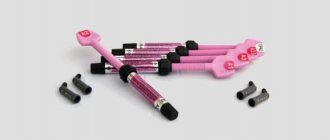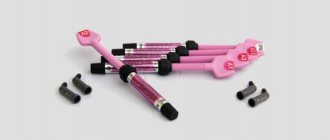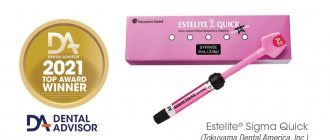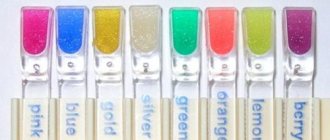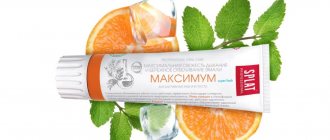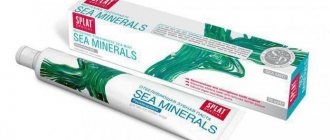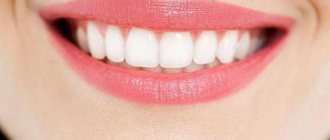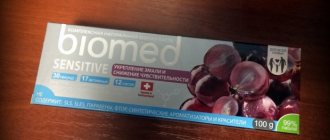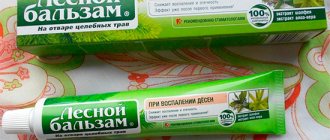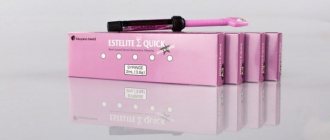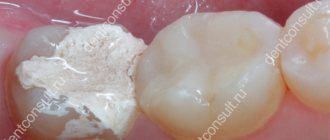The most common problem in the oral cavity, which 90% of people face, is caries. It is treated with a filling. There are now quite a lot of varieties of filling composites. Let's consider modern high-quality material made in Japan "Estelight". These are light-curing filling materials that are used by dentists for filling and restoration of teeth. Due to the presence of a large number of shades, it is possible to fill both the chewing teeth and the front teeth.
What is a light seal and how is it different from a regular one?
Light filling refers to modern composites that are manufactured under the influence of a strong light source. This material contains a substance that is sensitive to light. Under the influence of ultraviolet radiation, it breaks down into radicals and thus a polymerization process occurs in the filling itself. Thanks to this, the shade that the dental filling material acquires is quite similar to the color of the nearby dentition.
Unlike a conventional filling, the luminous material hardens under the influence of a polymerization lamp, and the dentist can more accurately adjust it to its shape. In addition, such a filling is more durable than a regular one, and it is also easier to match the color to the dentition. To a prying eye, the light composite or reflector is invisible.
Estelite filling material: features and release form
Recently, dentists have been using Japanese materials to restore or restore tooth enamel. Their polymerization occurs in just 10 seconds (one layer), while the composite retains its softness and plasticity.
Using the material, you can mask through and volumetric defects, select the appropriate shade, which over time will acquire the color of the dentition. Dentists note that using the composite is very convenient, since it does not stick to the instrument and holds its shape well.
Estelite filling material is produced in special syringes with a volume of 3.8 grams and unit doses of 0.2 g, depending on the shades.
Common shades:
- BW – for pre-whitened teeth;
- WE – light-colored enamel;
- CE – transparent enamel;
- OA1-OA3 - opalescent shades that are used to restore the oral cavity of the 3rd and 4th classes.
You can also use shades as dentin shades if you restore tooth enamel in several layers at once. The material is suitable for baby teeth, but is not used on metal dentures.
The composite contains 82% silicon and zirconium, due to which shrinkage is minimal, and strength and wear resistance are high. It is a universal and easy-to-use material.
General presentation and purpose
Herculite is a unique composite material with light reflection. It has been produced for more than 20 years by the Italian company Kerr.
This enterprise began its work at the end of the 19th century. Thanks to its own developments and the addition of several leading companies from other countries, Kerr has become one of the world's largest manufacturers of consumables for dental practitioners. All products are of high quality.
Herculite technology is patented and is the world standard for restoration materials. The composite is a universal composition that recreates the natural properties of the tooth.
The substance can be used for the restoration of any dental cavities and defects:
- Filling cavities;
- Treatment of enamel erosions;
- Elimination of wedge-shaped defect;
- Correction of the shape and color of teeth;
- Restoration of ceramic dentures.
Areas of application
Dentists actively use Estelite fillings to treat dental caries. The material is used both for lateral (chewing) teeth and for restoring the aesthetics of enamel on the front teeth. Thanks to a special composition developed by Japanese scientists, the composite is resistant to mechanical abrasion and the surface shines.
Since this filling material is universal, it is used for both adults and children to treat baby teeth. The composite has also proven itself well on the dentition with veneers, in eliminating diastema, restoring the occlusal surface and opacity of the tooth. There are more than two dozen shades of fillings. But they are not used on teeth that have lost their color under the influence of tetracycline.
Filler
Excellent characteristics are due to modern filler; in Estelite Sigma Quick, 71% of the volume is submicron spherical strontium-zirconium and silicon-zirconium filler. The particles in the composite are almost perfectly the same size with a uniform distribution in the matrix - high fullness and provides low shrinkage (1.3%).
The wavelength of visible light is greater than the size of the filler particle, and therefore the light is perfectly scattered on the surface, creating an opalescence effect. Natural fluorescence and opalescence make the material invisible, and the tooth after treatment acquires aesthetic appeal.
The development of the Japanese company has successfully passed clinical trials in Japan, the USA and Europe and is now in service with leading clinics in these countries. Now in our dental center this material is used to treat caries and eliminate dental defects.
Principle of operation
Working with Estelite filling material is easy and simple, and filling occurs quickly, dentists note. Due to the same depth of demineralization and penetration of adhesive substances, the dentinal structures are filled simultaneously. The design as a whole is monolithic, without cracks, regardless of the structure of the surface of the tooth enamel.
An aesthetically attractive, high-quality and durable filling is placed in a minimum amount of time. In this case, caries no longer occurs in this place, since the material releases fluoride ions.
Mode of application:
- The surface of the dentition is treated with paste (without fluoride).
- The appropriate shade is selected (filling of whitened teeth can be done no earlier than two weeks after the procedure).
- The tooth is isolated using a rubber dam and the cavity is sanitized.
- In order to avoid sharp changes from the restored area to the edge, the enamel of the lateral tooth is smoothed, and a bevel is made along the edge on the front dentition.
- To restore an artificial tooth (ceramic or composite), a diamond bur is used to increase adhesion and roughen the surface.
- Etching occurs using phosphoric acid.
- A glass ionomer material or calcium hydroxide liner is used to protect the pulp.
Advantages
The main advantages of using the Japanese Estelite material are its versatility and aesthetics. The brand’s nanocomposite called “Sigma Quick” is suitable for the restoration and restoration of both chewing teeth and the anterior row.
The filling material “Estelight Sigma Quick” has many advantages:
- used both to restore color and to give the correct shape to the front or lateral dentition;
- high wear resistance (tooth enamel does not wear off or deform during prolonged use);
- a large number of shades, which makes it possible to choose the most suitable one for the dentition;
- has a “chameleon effect” (the filling acquires the shade of the tooth over time, this in turn minimizes the incorrectly selected material);
- simplicity and speed of application;
- the surface of the tooth is shiny and smooth.
But the Russian market also offers Italian-made material “Estelight Asteria”, which has similar qualities and advantages to the Japanese product. The only difference between these two filling materials is that “Asteria” has a somewhat limited range of colors, and is also applied to the tooth in two layers. The remaining characteristics, high quality, and also the price are almost the same.
Composition and properties
Functional characteristics, which experts respond positively to, are achieved through a combination of components of the composite mass. The majority - up to 80% - is occupied by a silicon-zirconium compound, which prevents shrinkage of the filling and disruption of the seal of the connection after installation. The product range includes models of more than 20 shades, which allows you to choose the optimal shade that matches the natural tone of your tooth enamel. The polymerized surface is subject to polishing, due to which the effect of youth and newness is restored.
How is preparation and recovery going?
In order to choose the right shade of the Estelite nanocomposite, there is a certain scale. But this is not the only thing you need to pay attention to. If in doubt, dentists prefer a lighter shade, because the comparison takes place on wet teeth, and they are known to be somewhat darker. You should start working with whitened teeth no earlier than 14 days after the procedure, since they tend to darken.
The material is applied to the cavity in layers of 2 ml each. Polymerization occurs after each applied layer. It is important to monitor the thickness and curing time. Final processing is carried out using a diamond bur, and polishing is done with a rubber head.
When installing a light filling, the question often arises about how long after you can eat or drink liquids. Here the dentists were divided into two groups. The first believes that you can eat and drink immediately after the manipulation, but you need to limit the intake of products with coloring pigments for the first two days.
Another group of dentists is confident that you should still abstain from eating or drinking water for two hours after installing a light filling. They motivate this by the fact that after exposure to light irradiation, the place of the tooth where the filling is installed is sensitive for some time and has increased permeability. This may cause pain or change the color. This is especially true for the restoration of the front teeth.
Characteristics and equipment
The Herculite composition is intended for the restoration of both teeth in the “smile zone” and chewing dental units. The list of manipulations carried out with the help of the product includes restorations of classes I, II, III, IV and V.
This makes Herculite a universal remedy for restoring the functionality and aesthetics of teeth. In addition, with the help of the substance it is possible to treat other destructive changes in teeth and produce thin onlays.
The majority of Herculite's mass is mineral filler, with an average particle size of 0.6 microns . In this regard, the material has a high density.
The composition contains unique Point 4 particles (0.4 microns) and nanoparticles (0.2 microns). The presence of these particles in the composition gives the cured composite excellent polishability and gloss properties.
The material has high (250% Al) radiopacity, which allows hardware control of the correct application.
Thus, Herculite material opens up wide possibilities for the restoration of complex dental units, while possessing all the desirable properties of a composite.
The products are available in sets of various configurations. Here is a list of the main delivery options.
Mini set Herculite XRV
The Herculite Mini Kit includes the following items:
- Syringes (2 pieces, 3 g each) with enamel-colored material;
- Syringe (3 g) dentin color;
- Lining material (3 ml);
- Etching gel (3 g) + nozzles for application;
- Applicators.
The Mini set is enough to restore several teeth, provided the enamel color matches the range of shades included in the set.
Herculite XRV Custom Kit
The Custom set contains the following components:
- Syringes (6 pieces, 5 g each) with enamel-colored material;
- Lining material (5 ml);
- Etching gel (3 g);
- Liquid sealant (5 ml);
- Applicators and nozzles.
The Custom set contains basic enamel shades that allow you to recreate the dental units in most patients.
Herculite XRV General Set
The General set includes the following components:
- Syringes (10 pieces, 5 g each) with enamel-colored material;
- Syringes (4 pieces, 5 g each) with dentin-colored material;
- Syringes (2 pieces, 2.5 g each) for restoration of the cutting edge;
- Lining material (5 ml);
- Liquid-sealant;
- Syringe (3 g) with etching gel + 10 nozzles for application;
- Applicators and containers.
In the set, each syringe with material corresponds to one shade on the Vita scale. Thus, the General set contains a wide range of enamel and dentin shades.
Important points
When using Estelite filling material, it is important to pay attention to the integrity of the packaging. Since the product is widely known in many countries, there is a possibility of purchasing a fake, which is significantly inferior in quality to the original.
Precautionary measures when using the Estelite nanocomposite:
- use only with medical gloves;
- if the material gets on the mucous membrane, in the eyes, respiratory organs or on clothing, you should immediately rinse the surface;
- The composite can only be used in accordance with the instructions;
- the material is purchased only by professional dentists or clinics that have the appropriate license;
- after using the filling material, all instruments are sterilized;
- Polymerization with the device is carried out only in protective glasses.
Precautions and storage conditions
The use of the Herculite composite requires compliance with certain storage conditions and precautions:
- The shelf life of the composite mixture is three years from the date of manufacture. It is indicated on the packaging;
- Herculite must be stored in a dark place at a temperature from 18⁰C to 24⁰C;
- After the expiration date, the material must not be used;
- Syringes are stored closed after use;
- It is recommended to polymerize the composite mixture using a helium lamp;
- Until use, the material should not be exposed to light;
- Always use disposable applicators and palettes.
Contraindications
For some people, the use of Estelite material may cause allergic reactions to one or another component in the composition (most often to methacrylic monometers). In this case, you should stop using it and look for an analogue. There are no other contraindications to the use of nanocomposite, which is why it is considered universal, since it is used even for treating the teeth of small children.
After filling, the oral cavity is thoroughly cleaned and rinsed with water to avoid material getting into the mucous membrane or into the esophagus. Composite particles may cause irritation or other health problems.
Reviews
According to reviews, the Estelite filling material is assessed only positively by clients of dental clinics. Its strength, high wear resistance, quality and aesthetically beautiful tooth after filling are noted. In addition, the risk of developing caries in this area is minimal.
Some clients noted that when installing a light filling with this material, it did not change either the shade or the quality even after several years. It is well tolerated even by children, since the procedure does not take much time.
Warnings
There are certain precautions when working with mixtures:
- The material is squeezed out very carefully and slowly, which will ensure uniform distribution;
- One layer of the mixture cannot exceed a thickness of 2 mm;
- Each layer must be polymerized for 40 seconds;
- When restoring a large cavity, it is necessary to carry out polymerization on all sides.
Types of profiles in dentistry and instructions for using dental instruments.
In this publication you will find a detailed description of the Atatsamit filling material.
Here https://www.vash-dentist.ru/lechenie/zubyi/plombyi/kornevyih-kanalov-metodom-lateralnoy-kondensatsii.html all the most important things about filling the root canal using the lateral condensation method of gutta-percha.
